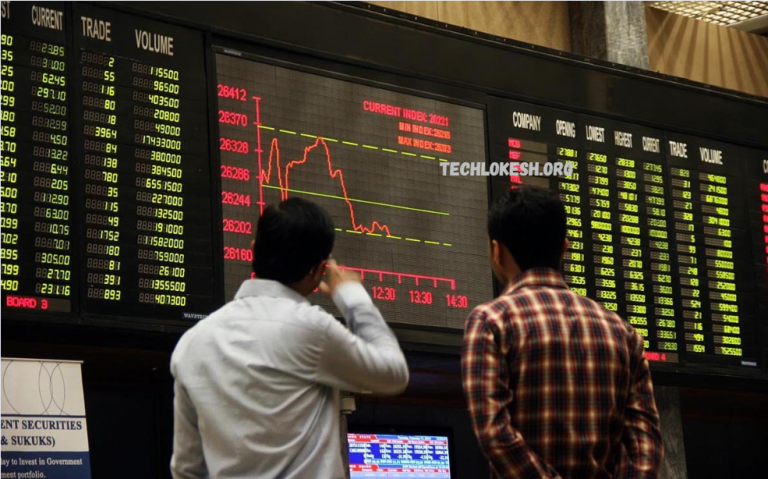After reaching record-breaking highs, the Pakistan Stock Exchange (PSX) is now showing signs of a pullback, and investors are taking notice. In recent sessions, the benchmark KSE-100 index has dipped, triggering a wave of profit-taking as investors cash in on earlier gains. This decline follows months of bullish momentum, driven by improved economic indicators, increased investor confidence, and expectations tied to political stability.
While some may view the drop as a cause for concern, many market analysts suggest it’s a natural correction — a pause after a steep climb. As seasoned investors know, no rally lasts forever. The recent decline reflects a shift in sentiment as participants lock in profits and brace for potential short-term volatility.
At the same time, macroeconomic factors such as inflation trends, interest rate expectations, and currency fluctuations continue to influence investor decisions. With uncertainty still lingering in the global and regional financial landscape, many are rebalancing portfolios or moving toward safer assets.
Overview of PSX Performance and Recent Record Highs
The Pakistan Stock Exchange (PSX) has delivered a notable performance in recent months, marking a strong recovery and a renewed surge in investor interest. The benchmark KSE-100 index surged to record highs, driven by a combination of improved economic indicators, favorable government policies, and increased confidence in market stability. This bullish momentum was also supported by optimism surrounding ongoing IMF negotiations, better-than-expected corporate earnings, and easing political uncertainty.
During this rally, the PSX attracted both local and foreign investors, with several sectors—particularly banking, energy, and cement—posting significant gains. Trading volumes rose steadily, reflecting growing participation and a return of positive sentiment in the equity market.
However, after touching new peaks, the index has begun to cool off as investors lock in profits. This pullback is not unusual after such a strong upward run and is generally viewed as a healthy market correction. It allows valuations to stabilize and offers long-term investors a chance to reassess entry points.
Factors Contributing to the Decline
Several key factors have contributed to the recent decline in the Pakistan Stock Exchange (PSX) following its record highs. While the overall market outlook remains cautiously optimistic, short-term pressures have triggered a wave of profit-taking and investor repositioning. Here are the main reasons behind the pullback:
Profit-Taking After Record Gains:
After a sustained rally, many investors chose to cash in on their gains. This is a typical market reaction when stocks become overbought or valuations stretch beyond comfort levels.
Interest Rate Uncertainty:
Concerns about the State Bank of Pakistan’s next monetary policy decision have added to market caution. If interest rates remain high or increase further, it could dampen investment appetite in equities.
Global Economic Pressures:
Fluctuations in global oil prices, concerns about slowing global growth, and geopolitical tensions have impacted investor sentiment. Emerging markets, such as Pakistan, are particularly vulnerable to these external shocks.
Currency Volatility:
The Pakistani rupee has shown signs of pressure, which can affect foreign investor confidence and increase costs for import-heavy sectors.
Political Developments:
Ongoing political uncertainty and speculation around policy shifts can create hesitation among investors who prefer stability before committing fresh capital.
Together, these factors have contributed to the current cooling-off phase in the PSX.
Market Reactions: Analyzing the Broader Impact
The recent dip in the Pakistan Stock Exchange (PSX) has triggered a wave of reactions across market participants, signaling a shift in sentiment after an extended rally. While some view it as a routine correction, others interpret it as a warning sign ahead.
Investor Sentiment:
Retail and institutional investors are reassessing their positions, with many shifting toward more defensive sectors or liquidating holdings to lock in profits. The initial euphoria that drove the index to record highs has now given way to a more measured, wait-and-see approach.
Sector Performance:
Sectors that had gained significantly during the uptrend—such as banking, energy, and cement—are seeing mixed reactions. Some stocks are under pressure, while others remain resilient due to strong fundamentals or dividend expectations.
Foreign Investment Flows:
Foreign investors, often more sensitive to macroeconomic and currency risks, have slowed their activity. While outflows have not been drastic, there’s a visible drop in participation as global risk appetite remains uncertain.
Market Liquidity and Volatility:
Trading volumes have slightly declined, and volatility has increased. Short-term traders are active, but long-term investors appear more cautious, waiting for clearer economic and political signals to emerge.
Overall, the broader market reaction suggests a phase of consolidation, as investors recalibrate their strategies in response to evolving economic conditions.
Read Also: Breaking News – Nepra Slashes Power Prices – What This Means for Your Energy Bills!
Technical Analysis of PSX Stock
From a technical analysis perspective, the Pakistan Stock Exchange (PSX), particularly the benchmark KSE-100 index, appears to be entering a consolidation phase after reaching record highs. Following a strong upward trend that pushed the index past key resistance levels, recent sessions have shown signs of weakening momentum. This is evident from the formation of short-term reversal patterns on daily charts, such as bearish candlesticks and narrowing trading ranges, which often signal indecision in the market.
The Relative Strength Index (RSI), a key momentum indicator, had previously entered overbought territory, suggesting that the market was due for a correction. As the index began to decline, the RSI has since eased, reflecting reduced buying pressure. This pullback is a typical technical reaction when prices climb too far, too fast. Additionally, the Moving Average Convergence Divergence (MACD) indicator has shown signs of a bearish crossover, which may indicate a shift in trend if the selling continues.
Support levels are now being tested. The index is hovering around its 20-day and 50-day moving averages, which are critical in determining whether the current movement is a temporary dip or the start of a deeper correction. If these levels hold, it could suggest underlying strength and a potential base for the next upward move. However, a sustained break below these averages might trigger further downside, as investors reassess risk in the face of both domestic and global uncertainties.
Historical Context: Previous Record Highs and Declines
The Pakistan Stock Exchange (PSX) has a history of sharp rallies followed by equally significant corrections, reflecting the broader economic and political cycles that influence investor sentiment. Looking back, the KSE-100 index first gained global attention in the early 2000s, particularly between 2002 and 2007, when it delivered strong returns driven by economic liberalization, increased foreign investment, and corporate profitability. That rally, however, was interrupted by the global financial crisis in 2008, which temporarily froze the market due to a price floor and led to a steep decline once normal trading resumed.
Another major high came in May 2017, when the KSE-100 crossed the 52,000-point mark following Pakistan’s inclusion in the MSCI Emerging Markets Index. This milestone sparked optimism, but the rally proved unsustainable as political instability, a widening current account deficit, and currency devaluation triggered a prolonged downturn. The market lost significant value over the next two years, with investor confidence shaken by inconsistent policy measures and macroeconomic challenges.
In recent years, the PSX has begun recovering, particularly after securing an IMF bailout in 2019 and experiencing relative political stability. The post-COVID period added further momentum, driven by low interest rates and a global push toward equities. The most recent record highs in 2024 reflected a blend of improved fiscal discipline, investor optimism, and reforms, but the market’s pullback in 2025 is consistent with previous cycles, where gains are often followed by periods of profit-taking and consolidation.
Frequently Asked Questions
Is it a good time to buy the dip?
For long-term investors with a solid strategy, corrections often present opportunities to buy. However, it’s essential to research and assess risks carefully.
What role does political uncertainty play in this decline?
Political developments often influence market sentiment in Pakistan. Any uncertainty or instability can trigger caution and lead to temporary sell-offs.
Are foreign investors withdrawing from the market?
Foreign investor activity has slowed, partly due to global economic concerns and currency risks. However, there hasn’t been a mass exit.
What technical indicators are signaling a downturn?
Indicators such as the Relative Strength Index (RSI) and Moving Average Convergence Divergence (MACD) have shown signs of weakening momentum, suggesting a potential cooling-off period.
What should investors do now?
Stay informed, avoid emotional decisions, and focus on your long-term goals. Diversify your portfolio and consider speaking to a financial advisor for guidance.
Conclusion
The recent decline in the Pakistan Stock Exchange, following its record-breaking highs, reflects a natural and expected phase in the market cycle. While the pullback may raise concerns for some, it also serves as a reminder that corrections are a regular part of healthy market behavior. Profit-taking, shifting investor sentiment, and broader economic factors have all contributed to the current dip.

